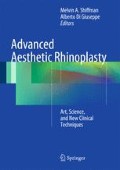Abstract
Asians include people living in Eastern Asia, Southeast Asia, India, and the Middle East who have different ethnic origins and different aesthetic features. As a result of the diverse ethnicities in these populations, the anatomic characteristics of Asians vary greatly. Although there are substantial variations, in the typical Asian nose, the nasal skin tends to be thicker than Caucasian noses, with abundant subcutaneous soft tissue. The tip of the nose is usually low and the lower lateral cartilages are small and weak. The nasal bones are poorly developed and thick, thus having low radix. The septal cartilage is thin and small. The amount of harvestable septal cartilage is usually insufficient for simultaneous use for multiple grafts. The author discusses surgery of the dorsum and nasal tip.
Access this chapter
Tax calculation will be finalised at checkout
Purchases are for personal use only
References
Kim JS, Khan NA, Song HM, Jang YJ (2010) Intraoperative measurements of harvestable septal cartilage in rhinoplasty. Ann Plast Surg 65(6): 519–523
Wang JH, Jang YJ, Park SK, Lee BJ (2009) Measurement of aesthetic proportions in the profile view of Koreans. Ann Plast Surg 62(2):109–113
Stucker FJ, Shaw G, Ephrat M (2002) Biologic tissue implants. In: Papel ID (ed) Facial plastic and reconstructive surgery, 2nd edn. Thieme, New York, pp 73–78
McCurdy JA (2002) The Asian nose: augmentation rhinoplasty with L-shaped silicone implants. Facial Plast Surg 18(4):245–252
Guerrerosantos J (1991) Nose and paranasal augmentation: autogenous fascia and cartilage. Clin Plast Surg 18(1):65–86
Toriumi DM, Swartout B (2007) Asian rhinoplasty. Facial Plast Surg Clin North Am 15(3):293–307
Bateman N, Jones NS (2000) Retrospective review of augmentation rhinoplasties using autologous cartilage grafts. J Laryngol Otol 114(7):514–518
Welling DB, Maves MD, Schuller DE (1988) Irradiated homologous cartilage grafts. Long-term results. Arch Otolaryngol Head Neck Surg 114(3):291–295
Strauch B, Wallach SG (2003) Reconstruction with irradiated homograft costal cartilage. Plast Reconstr Surg 111(7):2405–2411
Lefkovits G (2004) Nasal reconstruction with irradiated homograft costal cartilage. Plast Reconstr Surg 113(4): 1291–1292
Song HM, Lee BJ, Jang YJ (2008) Processed costal cartilage homograft in rhinoplasty: the Asan Medical Center Experience. Arch Otolaryngol Head Neck Surg 134(5):485–489
Jang YJ, Wang JH, Sinha V, Song HM, Lee BJ (2007) Tutoplast-processed fascia lata for dorsal augmentation in rhinoplasty. Otolaryngol Head Neck Surg 137(1):88–92
Jang YJ, Kim JH (2011) Use of tutoplast-processed fascia lata as an onlay graft material for tip surgery in rhinoplasty. Otolaryngol Head Neck Surg 144(4):528–523
Jang YJ, Song HM, Yoon YJ, Sykes JM (2009) Combined use of crushed cartilage and processed fascia lata for dorsal augmentation in rhinoplasty for Asians. Laryngoscope 119(6):1088–1092
Tham C, Lai YL, Weng CJ, Chen YR (2005) Silicone augmentation rhinoplasty in an oriental population. Ann Plast Surg 54(1):1–5
Erlich M, Parhiscar A (2003) Nasal dorsal augmentation with silicone implants. Facial Plast Surg Clin North Am 19(4):325–330
Wang JH, Lee BJ, Jang YJ (2007) Use of silicone sheets for dorsal augmentation in rhinoplasty for Asian noses. Acta Otolaryngol Suppl 558:115–120
Jung YG, Kim HY, Dhong HJ, Park KN, Lee HJ, Lim YJ, Min JY (2009) Ultrasonographic monitoring of implant thickness after augmentation rhinoplasty with expanded polytetrafluoroethylene. Am J Rhinol Allergy 23(1):105–110
Godin MS, Waldman SR, Johnson CM Jr (1999) Nasal augmentation using Gore-Tex: a 10-year experience. Arch Facial Plast Surg 1(2):118–121
Gunter JP, Landecker A, Cochran CS (2006) Frequently used grafts in rhinoplasty: nomenclature and analysis. Plast Reconstr Surg 118(1):14e–29e
Vuyk HD (1995) Suture tip plasty. Rhinology 33(1):30–38
Jin HR, Won TB (2009) Nasal tip augmentation in Asians using autogenous cartilage. Otolaryngol Head Neck Surg 140(4):526–530
Jang YJ, Lau BC, Min JY (2011) A multilayer cartilaginous tip grafting technique for improved nasal tip refinement in Asian rhinoplasty. Otolaryngol Head Neck Surg 145(2):217–222
Yu MS, Jang YJ (2010) Modified vertical dome division technique for rhinoplasty in Asian patients. Laryngoscope 120(4):669–672
Byrd HS, Andochick S, Copit S, Walton KG (1997) Septal extension grafts: a method of controlling tip projection shape. Plast Reconstr Surg 100(4): 999–1010
Hubbard TJ (2000) Exploiting the septum for maximal tip control. Ann Plast Surg 44(2):173–180
Author information
Authors and Affiliations
Corresponding author
Editor information
Editors and Affiliations
Rights and permissions
Copyright information
© 2013 Springer-Verlag Berlin Heidelberg
About this chapter
Cite this chapter
Jang, Y.J. (2013). Asian Rhinoplasty. In: Shiffman, M., Di Giuseppe, A. (eds) Advanced Aesthetic Rhinoplasty. Springer, Berlin, Heidelberg. https://doi.org/10.1007/978-3-642-28053-5_14
Download citation
DOI: https://doi.org/10.1007/978-3-642-28053-5_14
Published:
Publisher Name: Springer, Berlin, Heidelberg
Print ISBN: 978-3-642-28052-8
Online ISBN: 978-3-642-28053-5
eBook Packages: MedicineMedicine (R0)

